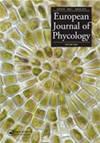形态学和分子研究揭示了西北太平洋棕榈科植物的多样性和分布
IF 1.7
4区 生物学
Q2 MARINE & FRESHWATER BIOLOGY
引用次数: 0
摘要
本文章由计算机程序翻译,如有差异,请以英文原文为准。
Morphological and molecular investigations shed light on diversity and distribution of Palmariaceae in the north-western Pacific
ABSTRACT Traditional morphology-based investigations of the red algal genera Devaleraea and Palmaria (Palmariaceae, Rhodophyta) fail to provide accurate accounts of diversity and distribution for species from the Russian coast of the north-western Pacific. Consequently, there is much disagreement and taxonomic uncertainty regarding several species. To resolve these issues we conducted a molecular-assisted investigation that included a DNA barcode survey (COI-5’) and multilocus (COI-5’, cob, psaA, ITS) phylogenetic analyses. Our analyses indicate that diversity was previously underestimated for the Devaleraea/Palmaria complex. We describe three additional species of Devaleraea: D. sakhalinensis sp. nov., D. kussakinii sp. nov. and D. urupiana sp. nov. We consider D. titlyanoviorum to be an alga with abundant proliferations from the margins, branching to several orders, that is known only from Kunashir Island. Algae from Sakhalin Island and the mainland coast of the Sea of Japan previously identified as D. titlyanoviorum are described here as D. sakhalinensis. We confirmed that the genus Palmaria is not monotypic. It includes at least two species: P. palmata in the North Atlantic and P. moniliformis in the north-western Pacific. We expand the known ranges of D. callophylloides, D. mollis and P. hecatensis in the north-western Pacific southwards and find that D. stenogona is confined to the northern part of the Sea of Japan. The distribution patterns of species of the genera Devaleraea and Palmaria are discussed in relation to the oceanography of the north-western Pacific. HIGHLIGHTS Three new species of the genus Devaleraea are proposed. The genus Palmaria is not monotypic and includes at least two species, P. moniliformis and P. palmata.
求助全文
通过发布文献求助,成功后即可免费获取论文全文。
去求助
来源期刊

European Journal of Phycology
生物-海洋与淡水生物学
CiteScore
4.80
自引率
4.20%
发文量
37
审稿时长
>12 weeks
期刊介绍:
The European Journal of Phycology is an important focus for the activities of algal researchers all over the world. The Editors-in-Chief are assisted by an international team of Associate Editors who are experts in the following fields: macroalgal ecology, microalgal ecology, physiology and biochemistry, cell biology, molecular biology, macroalgal and microalgal systematics, applied phycology and biotechnology. The European Journal of Phycology publishes papers on all aspects of algae, including cyanobacteria. Articles may be in the form of primary research papers and reviews of topical subjects.
The journal publishes high quality research and is well cited, with a consistently good Impact Factor.
 求助内容:
求助内容: 应助结果提醒方式:
应助结果提醒方式:


